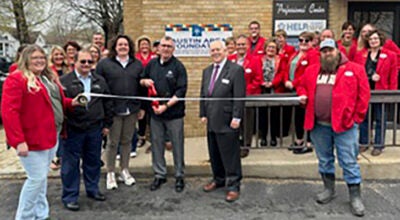An old home like new again
Published 5:07 pm Saturday, May 29, 2010
Mark and Taylor Bliese’s Fourth Street Northwest home in Austin is turning 100 this year.
When most things hit the centennial mark, it’s not too hard to notice — dust, rust, fading and warping are among the many telltale signs that something has been around for that long.
But enter the Blieses’ home, and you won’t see a century’s worth of wear. Instead, you’ll see a beautifully renovated and remodeled space with the most modern of amenities.
Of course, getting to this point wasn’t easy. Bringing the home from 1910 to 2010 has required time, money, patience and a good eye for design on the part of the Blieses. But their story doesn’t have to be unique; they did a majority of the work themselves, and you can, too.
Here is how the Blieses approached their 100-year-old home, plus a few tips from the homeowners on how others can replicate their style:
Floors first
It might seem like common sense, but starting from the bottom up is something not to forget during a redesign, Mark Bliese, 39, said. So, when he and Taylor, 31, moved into the house in 2003, the floors were one of the first areas to get attention.
That meant tearing up carpet and restoring the original hardwood. Mark said he and Taylor both liked hardwood, but the couple noted that going this route is something one really needs to be committed to. That’s because tearing up carpet takes time, and the condition of the wood underneath is a crapshoot.
Ultimately, the choice came down to one of Mark’s golden rules for people thinking about remodeling: Decide what you like.
In the Blieses’ case, that meant hardwood in most of the house’s rooms.
Maintaining integrity
During a remodeling project, it can be easy to look for the newest and neatest gadgets for a home. But often, the newest and neatest isn’t the right fit for a 100-year-old property.
So the Blieses made an effort to maintain the house’s original look and feel as much as possible. That doesn’t mean they avoided modern technology — the house has an energy efficient air conditioner, new appliances and a TV in a downstairs bathroom — but it does mean they tried to not let it overwhelm the home.
Examples of this philosophy are rampant throughout. The upstairs guest bathroom was given a vintage “candy parlor” treatment, but also outfitted with a sleek, modern glass shower. Downstairs, the living room is decked out with a flatscreen TV, but stylized in a more classic fashion, complete with restored hardwood floors, a wood bookshelf area with a built-in bench, and old-fashioned light fixtures.
Mark recommends several resources when looking to maintain a vintage feel, including various restoration-oriented outlets (see sidebar) as well as salvage stores.
But sometimes, a retro feel can be achieved simply by looking through what a house already has. In the Blieses’ case, that meant stumbling upon a few advertisements for a 1930s Austin-area traveling variety show in the attic. The fliers were in good condition, so the couple framed them. They now adorn the wall above the first-floor landing.
All in all, the Blieses have looked to modernize responsibly.
“We feel we owe it to the house,”
Mark said, “to stay true to how
it was made.”
A little flair
Even while sticking with a vintage feel, a homeowner can have a little bit of fun. For the Blieses’, the upstairs guest bathroom is a a perfect example — the dark wood design is very old-fashioned, but it is accented by a lively paint job and the aforementioned modern shower.
Other areas in the house are likewise given a splash of life, whether through paint jobs or other design techniques. Take the main stairway — a bright argyle wall finish is accented by two old columns recovered from a New York church and ornate stylings along the rail.
The master bedroom has the same old-fashioned hardwood vibe as the rest of the home, but the Blieses gave it a Thai sensibility by adding bamboo blinds and several pieces of elephant art.
Down the hall, the bedroom of one of the Blieses’ two daughters is given a touch of whimsy with hot air balloons painted on the walls. But again, the room is balanced with classic hardwood floors and vintage light fixtures.
A lot of flair
Still, it can’t hurt to make one room completely different.
Take the Blieses’ third-floor home theater, which was once an attic.
The only carpeted room in the house, the theater room also goes away from the wood theme so prevalent downstairs. Instead, Mark gave the room a “custom Tuscan” finish along the walls and added lights that change from color to color to spice it up.
Then there’s the atmospheric ceiling — small, flickering LED lights give the impression of being outside underneath the night sky.
With two young daughters — one 4, the other a newborn — and jobs to deal with, the Blieses haven’t found themselves in the theater as much as you’d think. But the unique room will get plenty of use in coming years, they said.
“We had fun [designing] this room,” Mark said. “We didn’t stick to the theme of the house.”
A feeling for ceilings
Though not every room in the house has twilight ceilings, Mark Bliese has made a point of putting a lot of attention into what he calls the “fifth walls.”
In several rooms — most noticeably being the living room — Mark built and put up wood ceiling covers that give a textured, classic look.
Each ceiling cover is constructed around light fixtures and hanging fans, with the objects sticking out through holes.
Mark acknowledges that the design is striking and might not be for everyone — again, he said it’s important for each homeowner to decide what he or she likes — but he said he’s hooked.
“I have a passion for ceilings,” Mark said.
The process requires doing some of the construction up on a ladder, but certain parts can be built on the ground and then hoisted up. Finishing off the design with crown molding gives it a very professional look — and also covers up any potential mistakes near the edges of the wood paneling.
So how does someone get such a feeling for ceilings? For Mark, it was simple — two kids and a dog running around the house can mean a lot of damage, but not when the decorations are high above.
“If I put my effort into a ceiling,” he said, “I knew it would be here.”
Odds and ends
Mark said the process of remodeling his home has evolved over the past seven years.
“We knew we’d have some work to do,” he said. “We did not know we’d do as much as we have.”
Indeed, the Blieses described the work as an ongoing passion, rather than a carefully planned exercise. Design ideas just seem to pop up, Mark said, and the remodeling goes from there.
But it is far from a perfect process — Mark said he and Taylor have wasted their share of time and scrapped their share of ideas over the years. Mark said it is part of a “trial by error” approach to home design.
“You make a lot of mistakes,” he said. “You waste a lot of wood.”
That’s not to say Mark isn’t very deliberate and patient when starting a project, traits he said he’s learned from a retired carpenter friend. Having such a friend and tapping him for knowledge has been a great tool, Mark said, and he advises people thinking about remodeling their own homes to seek out that type of guidance if possible.
Mark also recommends utilizing quality materials and, whenever possible, a “do-it-yourself” attitude. But perhaps most important, he said, is the simplest rule he knows: Decide what you like.
And if you’re Mark, that means liking — no, make that loving — the process of remodeling his and Taylor’s home.
“This has taken over as my passion,” he said. “I don’t have any regrets. We’ve got it the way we like it.”




